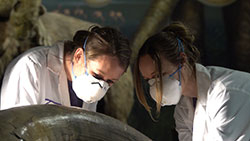In Southern California, there are two facilities that offer fascinating looks at the types of animals that roamed the land millions of years ago. The Western Science Center in Riverside County is home to 100,000 fossils and artifacts, all unearthed during construction of a nearby reservoir. The La Brea Tar Pits in neighboring Los Angeles County serves a similar purpose, storing a staggering 35 million prehistoric specimens discovered in and around the natural pits that continue to seep asphalt in the area.

Forensic Specialists Kelly Carrothers (l) and Ashley Spicer, from the California Department of Fish and Wildlife, remove samples from tusk at the La Brea Tar Pits, in Los Angeles.
In Southern California, there are two facilities that offer fascinating looks at the types of animals that roamed the land millions of years ago. The Western Science Center in Riverside County is home to 100,000 fossils and artifacts, all unearthed during construction of a nearby reservoir. The La Brea Tar Pits in neighboring Los Angeles County serves a similar purpose, storing a staggering 35 million prehistoric specimens discovered in and around the natural pits that continue to seep asphalt in the area.
Both facilities gladly open their doors to tourists and school field trips. Recently, they also welcomed two California Department of Fish and Wildlife forensic scientists, who traveled from Sacramento to collect samples of ivory tusks taken from Mammoths and Mastodons for a very specific purpose. Ashley Spicer and Kelly Carrothers came to collect the samples to take back to CDFW’s Wildlife Forensics Lab in Sacramento. The lab itself serves a number of purposes. In this case, the staff are collecting ivory samples for DNA testing and identification, under the auspices of a state law (AB 96) that makes it illegal to trade ivory or rhinoceros horn.
The Wildlife Forensics Lab maintains a species database that helps identify the origin of all kinds of ivory samples. The ability to pinpoint the source of any given ivory sample is critical when it comes to prosecuting criminal cases brought against suspected ivory traffickers.
“Mammoth and mastodon are species that are protected under AB 96 – you cannot commercialize them,” explained Spicer. “Examining the DNA allows us to identify the species of origin for any ivory-bearing species -- mammoth, whale, walrus, warthog or hippo. So, we can first distinguish whether a sample is ivory or not ivory, and whether it’s a fake or synthetic. If it is genuine ivory, then we can test it to see what was the species of origin.”
A key element of AB 96 was the closing of a loophole in previous laws. That loophole allowed the continued sale of tusk from mammoths and mastodons, because those animals were extinct. The exemption gave traffickers the chance to fraudulently claim that they were trafficking in legal material. Now that all forms of ivory trafficking are illegal – regardless of whether the species of origin is extinct – CDFW officials hope that an expanded DNA database will be the key to shutting down the ivory trafficking trade in California.
“The laboratory capability we have today helps us differentiate between ivory taken from an elephant that was poached in Africa within the last few years vs. ivory that was from an extinct species like a mammoth or a mastodon,” said Captain Patrick Foy of CDFW’s Law Enforcement Division. “This is huge for us – (now) we can actually prosecute these cases and convict these criminal poachers, to make the cases we couldn’t make 10 years ago,” said Foy.
CDFW is particularly grateful for the opportunity to obtain samples from the two Southern California facilities noted for their extensive fossil collections. “To be able to work with them (Western Science Center and La Brea Tar Pits) is a really exciting collaboration,” said Spicer. “These samples will be used for forensic testing methods, and ultimately for forensics case work that will help preserve some of our most precious natural resources.”
###
CDFW Photos. Forensic Specialists Kelly Carrothers (l) and Ashley Spicer, from the California Department of Fish and Wildlife, examine tusk at the Western Science Center in Riverside County.